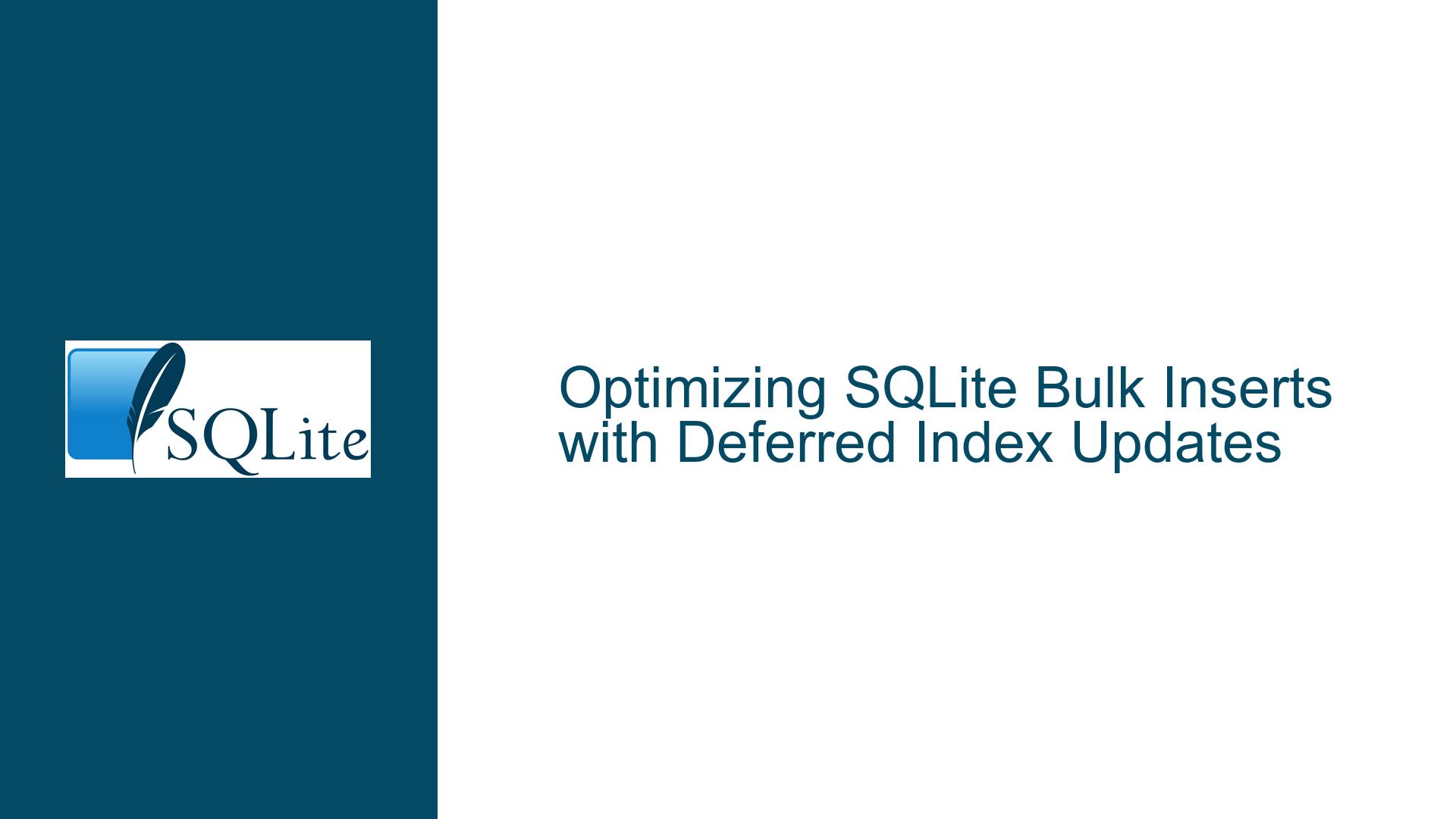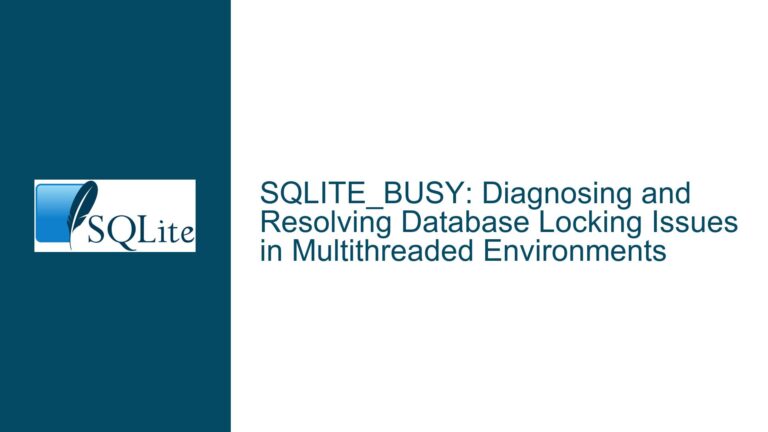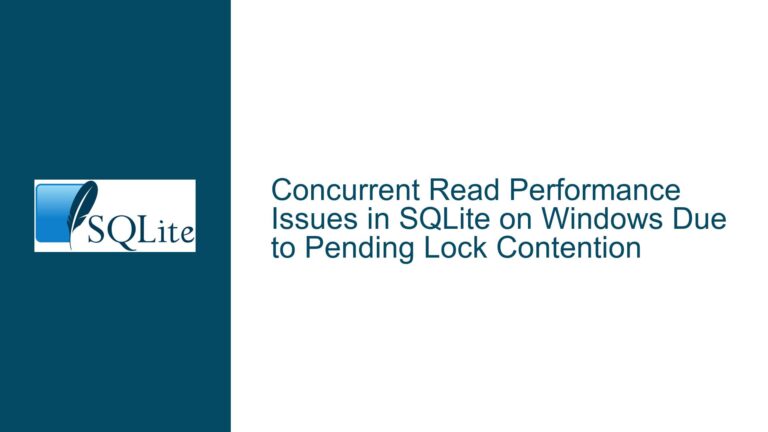Optimizing SQLite Bulk Inserts with Deferred Index Updates
Performance Degradation During Bulk Inserts with Index Updates
When working with large datasets in SQLite, particularly during bulk insert operations, performance degradation is a common issue. This is especially true when using INSERT … ON CONFLICT DO UPDATE statements, which are designed to handle conflicts by updating existing rows. The primary cause of this slowdown is the continuous updating of indexes during each insert operation. In scenarios where the dataset is being constructed from scratch, and no conflicts are expected, this continuous index updating is unnecessary and can lead to a runtime complexity of O(n^2 log n), where n is the number of rows being inserted.
The problem is exacerbated when dealing with datasets containing millions of rows, as each insert operation triggers an index update, which involves searching the index tree, updating the relevant nodes, and potentially rebalancing the tree. This process is repeated for every row, leading to significant overhead. The situation is further complicated when the dataset is being constructed from scratch, as the index updates are redundant and only serve to slow down the process.
In such cases, the ideal solution would be to defer index updates until all rows have been inserted, and then update the index in a single batch operation. This would eliminate the overhead associated with continuous index updates and significantly improve performance. However, SQLite does not natively support deferred index updates, which raises the question of how to achieve this behavior using existing SQLite features.
Continuous Index Updates and Insufficient Batch Sizes
The primary cause of performance degradation during bulk inserts in SQLite is the continuous updating of indexes. Each INSERT … ON CONFLICT DO UPDATE statement triggers an index update, which involves searching the index tree, updating the relevant nodes, and potentially rebalancing the tree. This process is repeated for every row, leading to significant overhead. In scenarios where the dataset is being constructed from scratch, and no conflicts are expected, these continuous index updates are unnecessary and only serve to slow down the process.
Another contributing factor is the size of the batches being processed in each transaction. If the batch size is too small, the overhead associated with starting and committing transactions can become significant. This is because each transaction involves flushing the write-ahead log (WAL) and updating the database file, which can be time-consuming. If the batch size is too large, on the other hand, the transaction may consume too much memory, leading to performance degradation due to memory pressure.
The size of the page cache also plays a role in determining the performance of bulk insert operations. If the page cache is too small, SQLite may need to frequently read and write pages to and from disk, which can significantly slow down the process. Conversely, if the page cache is too large, it may consume too much memory, leading to performance degradation due to memory pressure.
In summary, the performance degradation during bulk inserts in SQLite is primarily caused by continuous index updates, insufficient batch sizes, and suboptimal page cache sizes. Addressing these issues requires a combination of strategies, including deferring index updates, optimizing batch sizes, and tuning the page cache size.
Implementing Deferred Index Updates and Optimizing Batch Sizes
To address the performance degradation during bulk inserts in SQLite, several strategies can be employed. The first and most effective strategy is to defer index updates until all rows have been inserted. This can be achieved by dropping the index before starting the bulk insert operation and recreating it once all rows have been inserted. This approach eliminates the overhead associated with continuous index updates and significantly improves performance.
To implement deferred index updates, the following steps can be taken:
Drop the Index: Before starting the bulk insert operation, drop the index using the
DROP INDEXstatement. This will prevent SQLite from updating the index during the insert operation.Perform Bulk Inserts: Insert all rows into the table using plain
INSERTstatements. Since the index has been dropped, SQLite will not update the index during the insert operation, significantly improving performance.Recreate the Index: Once all rows have been inserted, recreate the index using the
CREATE INDEXstatement. This will update the index in a single batch operation, eliminating the overhead associated with continuous index updates.
In addition to deferring index updates, optimizing the batch size is also crucial for improving performance. The optimal batch size depends on several factors, including the size of the dataset, the available memory, and the performance characteristics of the storage device. A good starting point is to use a batch size of 10,000 to 100,000 rows, but this should be adjusted based on the specific requirements of the application.
To optimize the batch size, the following steps can be taken:
Determine the Optimal Batch Size: Experiment with different batch sizes to determine the optimal size for the specific application. This can be done by measuring the time taken to insert a fixed number of rows using different batch sizes and selecting the batch size that results in the shortest insertion time.
Adjust the Page Cache Size: Ensure that the page cache size is large enough to hold the working set of pages for the batch size being used. This can be done using the
PRAGMA cache_sizestatement. A larger page cache size can reduce the number of disk I/O operations and improve performance.Use Transactions: Perform the bulk insert operation within a transaction to reduce the overhead associated with starting and committing transactions. This can be done using the
BEGIN TRANSACTIONandCOMMITstatements.
By implementing deferred index updates and optimizing batch sizes, the performance of bulk insert operations in SQLite can be significantly improved. These strategies eliminate the overhead associated with continuous index updates and reduce the overhead associated with starting and committing transactions, resulting in faster and more efficient bulk insert operations.
In conclusion, the performance degradation during bulk inserts in SQLite is primarily caused by continuous index updates, insufficient batch sizes, and suboptimal page cache sizes. By deferring index updates, optimizing batch sizes, and tuning the page cache size, the performance of bulk insert operations can be significantly improved. These strategies are particularly effective when constructing large datasets from scratch, where no conflicts are expected, and continuous index updates are unnecessary.






